
Onychomycosis, also popularly known as nail fungus, is damage to the nail plate and surrounding structures caused by a fungal infection. Nails infected with fungi change color and transparency, become brittle, rough, thickened, flake and crumble. When this occurs, the tissue under or near the nail may become red and swollen.
Nail fungus is a very common disease. According to statistics, onychomycosis affects 8 to 26. 9% of the population worldwide, and in Russia the number of people with this diagnosis fluctuates from 4. 5 to 15 million people.
Typically, onychomycosis occurs in patients over 40 years of age. At the same time, there are no uniform statistics about the frequency of occurrence of the disease in men and women; the authors' opinions differ. In Russia, nail fungus is more common in men. At the same time, women are one and a half times more likely to see a doctor - perhaps this is due to a more attentive attitude to the health and appearance of the nails on the feet and hands. The photos may seem shocking.
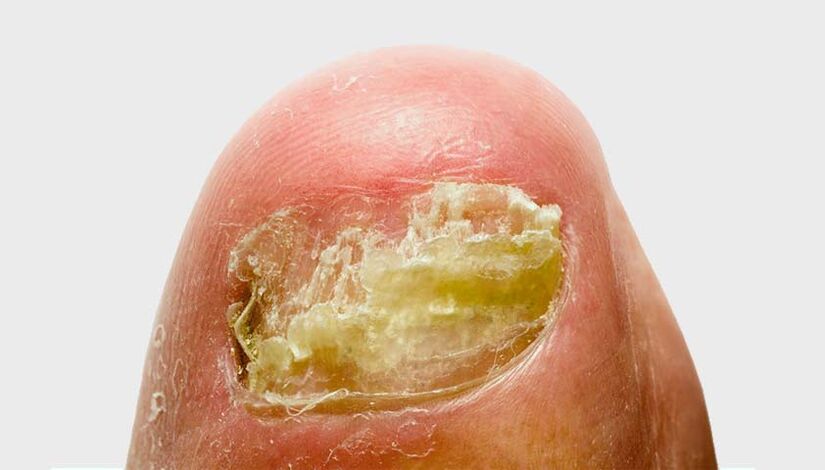
In around 80% of cases, the toenails are affected by the disease. Less commonly, onychomycosis affects the fingernails. Researchers have identified factors that significantly increase the risk of onychomycosis. They can be roughly divided into two groups.
External (exogenous) risk factors for the development of onychomycosis:
- nail injuries;
- prolonged wearing of tight, non-breathable shoes;
- Staying in a hot, humid climate.
Internal (endogenous) risk factors for the development of onychomycosis:
- Patient age: The disease is more common in people over 40 years old;
- obesity;
- reduced immunity;
- Concomitant diseases: diabetes mellitus, thyroid disease, varicose veins;
- flat feet and other foot deformities;
- Long-term use of certain medications: antibiotics, cytostatics, corticosteroids.
The familial factor plays a special role in the spread of onychomycosis. According to statistics, 55% of patients in the family had nail fungus.
You can become infected with onychomycosis through direct contact with an infected person, as well as through household items - clothing, shoes, hygiene products (washcloths, towels).
Infections occur in public places, especially in fitness studios, bathrooms, saunas and swimming pools. Scales containing pathogenic fungi end up on floors, benches, paths and trellises. Under such conditions, fungi continue to multiply and soon find new hosts.

Fungi that cause onychomycosis reproduce well in high humidity. In addition, you can catch onychomycosis in a manicure or pedicure salon if the master does not follow the rules of hygiene and sterilization of instruments.
Causes of onychomycosis
There are about 50 species of fungi that can affect the nail plate. At the same time, dermatomycetes of the genus Trichophyton account for up to 80–90% of onychomycoses of the feet and up to 36% of onychomycoses of the hands.
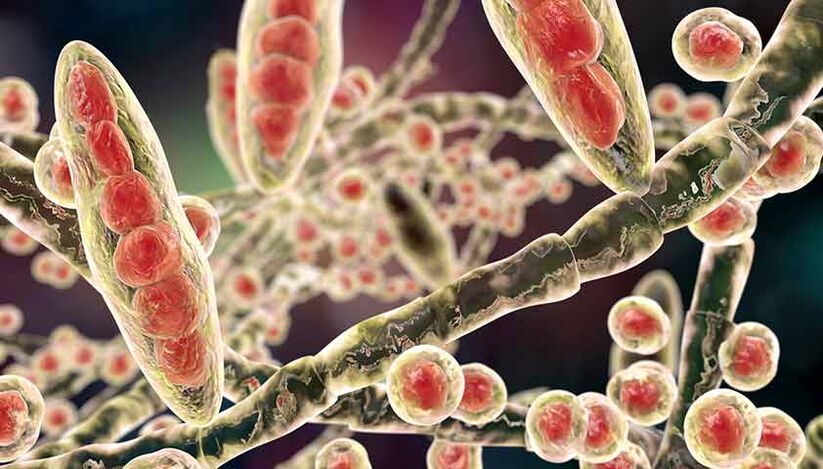
Dermatomycetes are microscopic fungi that attack skin, hair and nails. The second most common pathogens of onychomycosis are yeasts of the genus Candida (Candida). Nail candidiasis occurs in 5-10% of cases. Less common causative agents of onychomycosis are molds – Aspergillus (Aspergillus), Fusarium (Fusarium), Scopulariopsis (Spoculariopsis).
In practice, the nail plate is damaged by several types of fungi at the same time. Most often this is a combination of two types of dermatomycetes or variations of "dermatomycetes + yeast", "dermatomycetes + mold". In about 10% of cases, the patient is infected with three or more types of fungi.
Types of onychomycosis
In Russian dermatology, three types of onychomycosis are distinguished depending on the clinical manifestations of the disease.
Main types of onychomycosis:
- normotropic: the shape of the nail plate does not change, while whitish and yellowish stripes are visible in the thickness of the nail;
- hypertrophic: the nail plate noticeably thickens, becomes brittle and has jagged edges;
- dystrophic: The nail plate becomes thinner and separates from the nail bed.
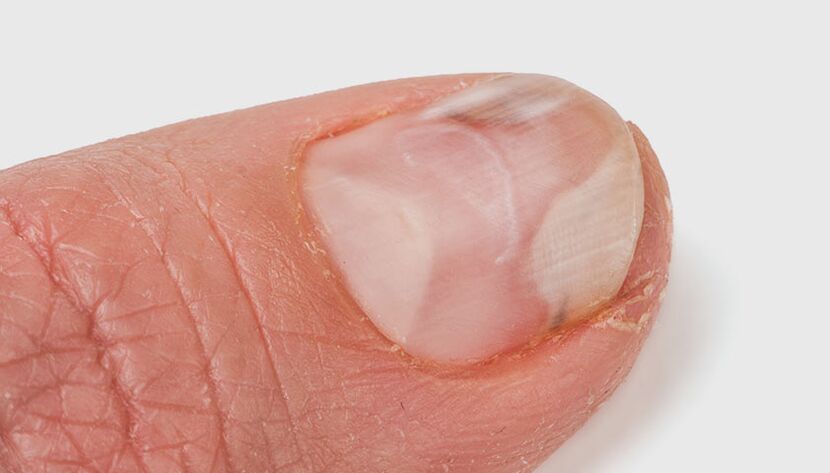
There are four types of onychomycosis depending on how the fungus got on the skin and nails.
Types of onychomycosis depending on the place of penetration and spread of the pathogenic fungus in the nail plate:
- superficially white: The fungus colonizes the upper part of the nail plate. Whitish lesions appear on the nail. As the infection spreads, the nail turns gray-brown and begins to crumble;
- Distal-lateral subungual: The fungus penetrates the skin in the area of the nail folds or the free edge of the nail. The nail plate becomes thicker, yellows, crumbles and then moves away from the nail bed.
- proximal subungual: The fungus spreads from the skin and nail folds to the nail plate and deeper. Spots appear on the nail in the area of the hole and nail bed. The nail plate peels off;
- totally dystrophic: the entire nail plate is affected. It looks very thickened and turns a dirty yellow color. The nail surface becomes uneven.
Once the fungal colony arrives on the nail plate or surrounding structures, it begins to grow towards the matrix - the growth zone located at the back of the nail bed. It is believed that the faster the nail grows, the more effectively it displaces the fungal colony and the faster healing from onychomycosis occurs. This mechanism also explains the fact that nail fungus mainly affects people over 40 years of age: their nails grow significantly slower than those of young people.
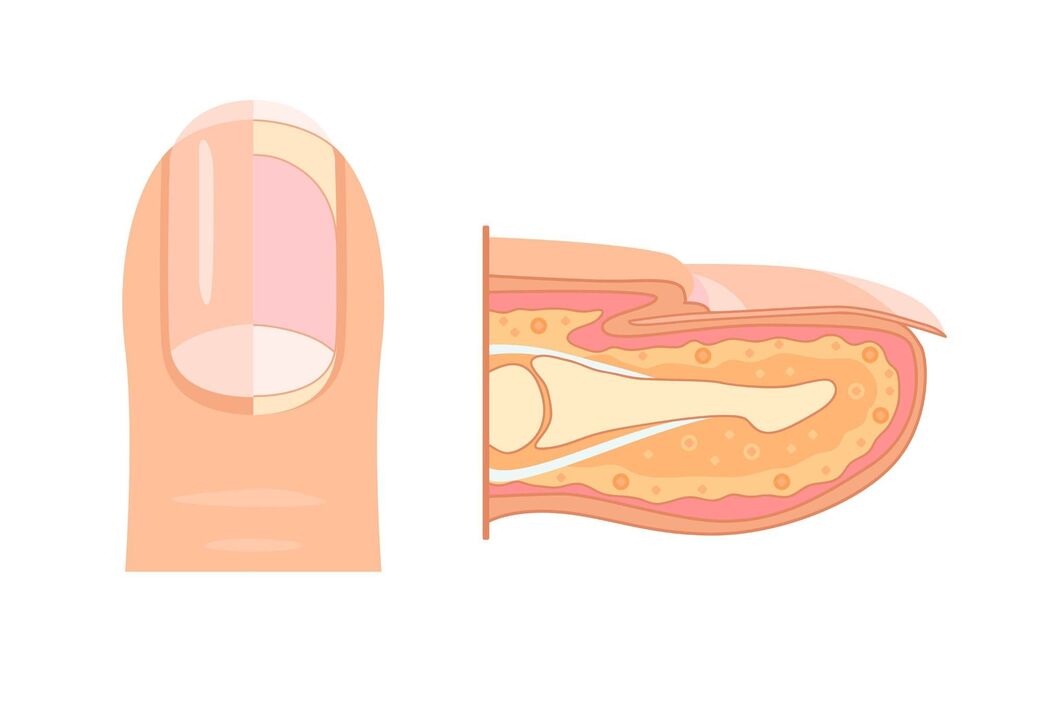
Symptoms of onychomycosis
As onychomycosis progresses, the symptoms of the disease worsen.
The main symptoms of onychomycosis:
- Change in the color of the nail plate to yellow, black, green, brown or gray;
- separation of the nail plate from the nail bed;
- change in the thickness of the nail plate;
- Koilonychia – the nail becomes concave and has the shape of a teaspoon;
- Onychogryphosis – the nail bends like the beak of a bird of prey;
- thickening of the nail bed;
- Change in the surface of the nail plate: formation of pits, grooves, ridges;
- Inflammation of the nail fold.
Complications of onychomycosis
Without treatment, onychomycosis in patients with diabetes can lead to serious complications, such as diabetic foot - ulcerative defects of soft tissues with damage to tendons and bone structures.
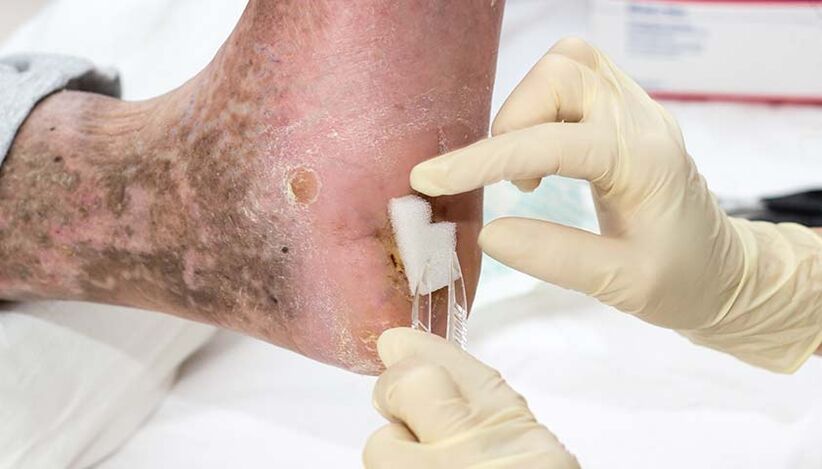
In people with a long-term fungal infection, as well as against the background of immunodeficiency, onychomycosis can cause a severe allergic reaction. This is explained by the fact that the fungal colony and its metabolic products act as sensitizers - triggers to which the body reacts with increased sensitivity.
As a result, an allergic reaction occurs, which can have various manifestations: a more severe course of bronchial asthma, the appearance of microbial foci of eczema and the development of urticaria.
Common complications of onychomycosis:
- diabetic foot;
- allergic reaction;
- chronic erysipelas of the extremities is an infectious skin lesion;
- Lymphostasis – retention of lymph fluid in tissue;
- Elephantiasis (elephantiasis, elephantiasis) is a progressive lymphedema simultaneously with the replacement of subcutaneous fatty tissue with connective tissue.
Diagnosis of onychomycosis
Onychomycosis is diagnosed and treated by a dermatologist. At the appointment, the doctor assesses the condition of the patient's nails, skin, mucous membranes and hair. He performs a dermoscopy and examines the skin under magnification. At the same time as the examination, the specialist takes an anamnesis and asks the patient about his lifestyle, the quality of his diet, his household habits and care measures. If onychomycosis is suspected, your doctor will order laboratory tests. By examining abrasions on the nail plate, a fungal infection can be ruled out or confirmed. The doctor may also refer the patient for microscopic examination and culture.
Diabetes mellitus can significantly worsen the course of onychomycosis and lead to serious complications. Extensive studies can rule out or confirm this diagnosis. A complete blood count helps to assess the patient's general condition.
Treatment of onychomycosis
Treatment of onychomycosis can be local, systemic or combined. Corrective therapy aimed at eliminating concomitant diseases may also be required. In local therapy, antifungal medications are applied directly to the nail plate and nail folds. In this case, the drug is concentrated on the surface of the nail and does not penetrate into the bloodstream, which eliminates the risk of side effects.
However, with local therapy, the drug cannot always reach the fungal colony, especially if it is located deep in the nail bed. Before applying topical medications, the affected part of the nail must be removed. At home, you can use a keratolytic patch - it contains a small amount of acid and can soften the nail.
Systemic therapy allows the antifungal to penetrate the affected area through the blood, regardless of how deeply the fungal colony is hidden.
The main types of systemic drugs used to treat onychomycosis:
- antifungals;
- Antiseptics – have both antifungal and antibacterial effects;
- Multicomponent drugs may also contain anti-inflammatory substances.
The treatment regimen and dosage of the drug are determined by the doctor. In combination therapy, systemic and local treatment are carried out simultaneously. This allows you to increase the effectiveness of treatment and shorten its duration.
The aim of corrective therapy is to treat concomitant diseases that can complicate the course of onychomycosis. These are primarily diabetes mellitus, thyroid diseases and vascular diseases (e. g. varicose veins). The treatment tactics are determined by the doctor and other specialists who, in this case, jointly care for the patient.
Prognosis and prevention
If you consult a doctor in a timely manner, the prognosis of onychomycosis is favorable: up to 80% of patients treated with antifungal drugs get rid of the disease forever. To prevent onychomycosis, you need to protect your feet and hands from irritating and traumatic factors and strengthen your immune system.
Measures to prevent onychomycosis:
- Change socks daily or more often if your feet are sweaty or wet.
- air or dry the shoes after wearing them;
- Do not wear communal slippers when visiting.
- Don't try on shoes barefoot in a store.
- Use a personal towel for your feet.
- Use individual tools for nail care (tweezers, files);
- Wear shoes in the swimming pool or sauna.
- Monitor the diversity of your diet;
- Avoid stressful situations.

























